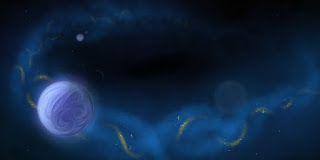Planet: Mythos

Planet: Mythos
Nebula: Celestial Laurel
Properties:
One sun, six large moons and thirty three satellite- small moons.
A large gaseous planet made up predominantly of hydrogen and helium, with raging storms so big they can be seen from far away by the naked eye.
__
The planet mythos resides in the Celestial Laurel Nebula, a nebula of stardust that appears to be interwoven but clusters of iridescent asteroids and debris that actually came from the disposal systems of a neighboring galaxy. The molecular structure of the compounds worked in such a way that the clusters of litter actually created a helix-like formation that from far away appears to be woven around the nebula itself.
Mythos does not have intelligent life on it the way one might consider it to be here on Earth, but instead is comprised of beautiful and complex organisms that can survive in a world without solid ground. These creatures are reminiscent of deep sea life on Earth. One Mythos day is equivalent to that of one year on Earth, meaning that much of life will have to adapt in prolonged periods of darkness, while others will have to adapt to live in prolonged exposure to light.
During the day periods large beasts that are reminiscent of sea turtles roam the skies, although they themselves aren't very light the sacks on their backs are filled with helium and regularly collect more from the ready supply in the atmosphere. As they wade through the planet they feed on microorganisms and filter the air through their airsacks. Vegetative life grows on the backs and act like small islands that will eventually become the building blocks of more complex organisms. As these mythosian beasts grow older their airsacks wear down, making it harder and harder for them to collect enough helium to remain at liveable altitudes. Eventually they will sink low enough that the elements they need to survive are no longer available; which means that those that live long enough to reach this stage die of suffocation or starvation.
Smaller avian like creatures roam the skies as predators, swarming in large flocks to take down the tortoises. Although the tortoises have very thick and durable skin, they are too slow to fend for themselves or attack- and often succumb to the sheer number and persistence of these creatures.
_
During the night periods the tortoises and avians are able to take shelter in the shell of the tortoises airsacks, which conserves enough heat for the behemoths to survive, still able to filter feed on the microorganisms as it drifts. The life surviving on the airsacks itself either recess into the pores of the sacks themselves, or have evolved to withstand extreme heat and cold like desert life.
The life that thrives in the darkness are bioluminescent drifters that weave their ways through the sky and filter fresh hydrogen and helium into the air while consuming the gases that the Daylighters emit.
Really cool references:
http://www.scifiideas.com/science-2/life-evolve-inside-gas-giant/
https://qz.com/917483/if-aliens-exit-on-trappist-1-exoplanets-theyll-be-living-in-dark-stormy-and-unpredictable-times/
Comments
Post a Comment